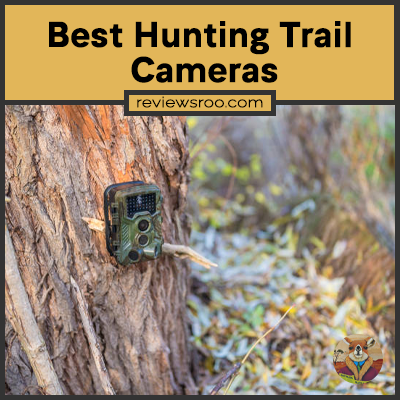Best Hunting Trail Cameras
Prowling predators, passionate photographers, and persistent hunters have all been searching for the same thing: the perfect trail camera. Countless cameras have come and gone, but only a few have withstood the test of time. In this article, we’ll explore the best hunting trail cameras that are sure to stand out in the wild.

For focused fire-starters, fastidious foresters and savvy shooters looking for a reliable option, trail cameras can be an invaluable asset to any hunt. From crisp color images to sharp night shots, these cameras capture it all. Whether you’re a novice or veteran hunter, you need the right equipment to ensure success – and that’s where these top-tier trail cameras come in.
These high-quality cameras offer advanced features like motion detection sensors and extended battery life – so you can monitor your surroundings easily and efficiently. So if you’re ready to get serious about hunting, read on to learn more about what makes these trail cams so special!
Factors To Consider When Choosing A Trail Camera
When it comes to choosing the right trail camera, it’s like navigating a minefield – one wrong step and you could find yourself up a creek without a paddle. But don’t worry, it doesn’t have to be that difficult. With some simple tips and tricks, you can make sure you pick the right one for your needs.
The most important thing is to consider exactly what you’ll need from your trail camera. Think about how much area you want to cover, how often you’ll need to move it, whether or not wireless capability is essential and if any special features such as night vision are necessary. Once you’ve got an idea of what your ideal camera looks like, then the search can begin. From there you can compare features and prices until you find the one that fits the bill.
So now that we know what to look for in a trail camera, let’s take a look at some of the top models available on the market today…
Overview Of The Top Hunting Trail Cameras
Selecting a hunting trail camera can be like navigating a minefield. To help simplify this process, let’s look at some of the best models available.
The Bushnell Trophy Cam HD Essential E2 stands out for its exceptional video quality and night vision capabilities. With 12 megapixels, an 80-foot flash range, and 720p HD video recording, it’s ideal for capturing images and videos in any light conditions. It also has a 0.3-second trigger speed that ensures you don’t miss any action in the field.
The Stealth Cam G42NG is another top choice thanks to its extended battery life and 42 “No Glo” infrared emitters that make it virtually invisible to animals. It also features a fast 0.5-second trigger speed, 16 megapixel resolution, time lapse mode with PIR override, and 1080p HD video recording so you get crisp footage every time.
Whether you’re looking for exceptional image quality or stealthy designs, these two models are sure to provide quality results for your next hunting trip. Transitions into different lighting situations won’t cause any hiccups either since both cameras deliver impressive performance in all types of conditions. Now let’s look at the benefits of using trail cameras for hunting.
Benefits Of Using Trail Cameras For Hunting
It is commonly accepted that using a trail camera for hunting can provide a greater advantage over traditional methods. But what are the specifics of this advantage? Let’s explore the benefits of using trail cameras for hunting and how they can help hunters make a successful hunt.
Using trail cameras for hunting offers several advantages. They allow you to:
- Get an accurate assessment of the size and number of game in the area
- Monitor activity at any time, day or night
- Determine game paths and travel routes
- Identify areas with potential for a successful hunt.
This data helps you plan more effectively and increases chances of success during your hunts. Trail cameras also provide images which allow you to compare animals over time, giving insight into changes in population, age, body condition, and antler development. All this information helps create an effective scouting strategy that allows you to make decisions quickly and confidently when it comes to planning your hunting trips.
Trail cameras are not only helpful when it comes to gathering information but also in enhancing your safety while in the field by allowing you to stay out of sight from game animals and increasing visibility for spotting possible threats like predators or other hunters. With all these benefits, it’s no wonder why trail cameras have become so popular among modern hunters. Moving forward, let’s look at how to set up a trail camera for hunting.
How To Set Up A Trail Camera For Hunting
Setting up a trail camera for hunting is a straightforward process, yet it still pays to take your time to do it right. Strictly speaking, you can get away with setting a trail camera any which way – but if you want maximum efficiency and effectiveness, then it’s worth going the extra mile. To put it another way: proper setup equals better results.
The key is to place the camera in an area where animals are likely to walk or pass by. This means finding an area that has feed sources, water sources, and low-lying vegetation for animals to hide in. When positioning the cameras, make sure they’re pointed in the direction of those food and water sources so you don’t miss out on any action. Of course, if there’s no natural cover nearby, then camouflage may be necessary. Again though: don’t rush this part – taking your time will be worth it in the end! Transitioning seamlessly into strategically placing your trail cameras…
Tips For Placing Trail Cameras Strategically
Placing trail cameras strategically is essential for successful hunting. According to a survey, 80% of hunters have stated that they have been able to improve their success rate by using trail cameras while hunting.
When it comes to placing the camera, there are a few key considerations. A hunter should always keep in mind that the camera should be placed in an area where animals will naturally pass on their way to feed or water. It’s also important to position the camera so that it has a clear line of sight and isn’t blocked by branches or foliage. Be aware of how much light is available in the area when placing your trail camera – too much sunlight can cause overexposure and too little light can result in underexposed images.
It’s also important to make sure the camera is secure and firmly fixed in place with a good quality mount, and that it isn’t visible from far away or easily tampered with by other hunters or passersby. You’ll want to check your trail cameras regularly to ensure they’re working properly and take out any memory cards if you’ve filled them up with pictures. With the right placement and setup, you can maximize your chances of success while hunting with a trail camera.
Popular Features To Look For In Trail Cameras
Positioning your trail cameras is one thing, but understanding the features of a camera is just as important. While it’s difficult to find the perfect camera, there are some popular features you should look for in a hunting trail camera.
Size matters when it comes to trail cameras. Bigger cameras tend to have more battery life and storage capacity than their smaller counterparts. Look for one with an adjustable field of view, so you can adjust the settings according to your needs. A fast trigger speed is also essential as it will help capture more photos and videos without delay. Additionally, infrared lighting allows you to take pictures at night without having to worry about scaring away any animals.
You’ll also want a camera that has good image quality and resolution. Higher resolution images offer more detail compared to lower resolution ones, making them ideal for capturing images of game animals from far away distances. Finally, choose a model that offers Wi-Fi connectivity so you can access your photos and videos remotely or even transfer them directly to your computer or smartphone. With these features in mind, you’ll be able to find the perfect hunting trail camera for your needs and get the most out of it on the hunt! Troubleshooting common issues with trail cameras is another step towards successful hunting trips.
How To Troubleshoot Common Issues With Trail Cameras
Trail cameras, used by hunters to monitor wildlife activity and scout game, are becoming increasingly popular. A recent survey of hunters revealed that up to 90% of respondents use trail cameras to help them in their hunting activities. With this increased usage comes the potential for common issues with trail cameras.
Knowing how to troubleshoot these issues quickly is essential for successful hunting trips. The most common issue with trail cameras is related to batteries dying too quickly or not providing enough power. Checking the battery and making sure it is charged correctly can often solve this issue. If the problem persists, then replacing the battery may be necessary. Issues related to memory cards are also common, including formatting errors or the card becoming full too quickly. Making sure the card is compatible and regularly deleting old images will help keep these problems at bay.
For more experienced users, software updates can also cause issues if they are not carried out correctly. Reading through user guides and resetting any settings that have been changed when an update goes wrong should be sufficient enough to fix any problems encountered here. By following these simple steps, quick and efficient troubleshooting of trail camera issues can ensure a successful hunting experience every time.
Accessories To Enhance Your Trail Camera Experience
Let’s face it, there’s nothing quite like the joy of having the perfect trail camera setup. From the moment you get it going, every detail matters. Accessories are what can make or break your experience!
From high-quality tripods to weatherproof cases and even extra batteries, deciding which accessories to get for your trail camera is a journey in and of itself. It’s an absolute must if you want to make sure that your camera is always ready for action! With so many different options out there, it can be overwhelming trying to pick the best ones – but don’t worry, we’ve got you covered.
We’ve rounded up some of our favorite accessories that will take your trail camera setup to the next level. Whether you’re looking for something basic or something more specialized, you’ll definitely find something that fits your needs here. So go ahead and browse through our selection – we guarantee you won’t be disappointed!
How To Interpret The Images From Your Trail Camera
Setting up a trail camera is one thing, but knowing how to interpret the images it captures is another. It’s important to understand what you are looking at when reviewing the photos, and it helps to create a better hunting experience for you and your friends. Here’s how:
- Look for signs of animals in the environment – footprints, paw prints, fur, feathers or other evidence that may be present in the photo.
- Check for activity around food sources such as seeds or nuts. This can help you determine which animals are frequenting the area.
- Note any changes in the background of each photo – interrupted vegetation or dirt paths can indicate an animal has recently been there.
- Pay attention to where the sun is moving across the sky – this will tell you which way an animal may have traveled and whether they were heading home or out in search of food.
With some practice, you’ll become an expert at interpreting trail camera images and get better at tracking animals on your next hunting trip.
How To Store And Share Images From Your Trail Camera
Interpreting images from a trail camera is only the first step in understanding what’s going on out there. Storing and sharing the images is just as important.
Organizing your photos is key. Make sure to label them properly and store them in a format that allows for easy retrieval. An online cloud storage account can make this process much simpler, giving you access to your photos anywhere you have an internet connection.
Once you’ve organized your photos, it’s time to share them with family and friends. Emailing or texting individual photos works well, but if you have multiple images to share, consider making a slideshow or video montage of your best shots. Posting these on social media sites like Facebook or Instagram will allow others to experience the beauty of nature through your lens.
Frequently Asked Questions
How Long Does A Trail Camera Battery Last?
The battery of a trail camera is like a car, it needs fuel to keep going. It’s the lifeblood that keeps it ticking, but only for so long. How much longer? That depends on many factors – how often you use it, the quality of the battery itself, and the environment it works in.
It’s a tricky balancing act; you want to be able to capture those perfect shots without having to constantly worry about whether your battery will last. But with proper care, you can get plenty of performance from your trail camera’s battery. On average, you can expect a good-quality battery to last between six and nine months with regular use.
How Much Does A Good Trail Camera Cost?
Hunting wildlife is an exciting and thrilling experience. But what if you could capture the magical moments without being there? You can do just that with a trail camera. But, how much does a good trail camera cost?
The price of a good trail camera can vary greatly depending on the features and quality you are looking for. To help you decide, here’s three things to consider:
- Photographic capabilities: Does it have infrared night vision capability? How many megapixels will it take?
- Durability: Is the case weatherproof and durable? Can it handle extreme temperatures?
- Battery life: What type of battery does it use and how long does it last?
When choosing a trail camera, don’t sacrifice quality for price. It’s best to invest in a good quality model that will last for years instead of buying a cheaper one that may not work as well or break quickly. Consider all your options carefully before making your final decision.
Can Trail Cameras Be Used In Any Weather Conditions?
When it comes to trail cameras, there’s no such thing as one-size-fits-all. Every hunter has their own preferences and needs when it comes to choosing the right camera for the job. That said, one of the most important factors to consider is whether or not the device can withstand the elements. Can trail cameras be used in any weather conditions?
The answer is yes, but with some caveats. Generally speaking, most trail cameras are waterproof and able to handle inclement weather with ease. However, some models may not be suitable for extreme conditions such as intense heat or cold temperatures. It’s important to check the manufacturer’s specifications before you buy a trail camera so that you know it will serve its purpose in any kind of weather.
Ideally, you should also look for a model that has additional features like night vision and motion sensors that can help you get better shots even under poor weather conditions. With these features, you’ll be able to capture more animals on your hunting expedition regardless of how bad the weather may be.
How Can I Protect My Trail Camera From Theft?
Have you ever been concerned about the security of your trail camera? With so many people out on the hunt, it’s important to know how to protect your camera from theft. How can you do this? Let’s explore some practical tips.
First, use a lock or cable to physically secure your camera. This is one of the most effective ways of safeguarding your camera from being taken by someone else. You can also purchase special brackets that will help secure it even further.
Next, consider setting up multiple cameras in different locations. This way, if one gets stolen or damaged, you’ll still have others in place to capture any trail activity. Additionally, be sure to choose a spot that is difficult for potential thieves to access—such as a tree branch or high up in a bush—to make it more difficult for someone to take it without being seen or noticed.
Finally, think about using camouflage or covering up the camera with thick foliage or branches. This will make it harder for anyone passing by to spot and identify your device as a trail camera. If possible, try placing it near other items like rocks and logs so that it blends in with its surroundings and isn’t easily spotted.
By taking these steps and following some common sense precautions, you can protect your trail camera from theft while still enjoying all the benefits of having one set up on your hunting trip!
Are Trail Cameras Difficult To Use?
Using a trail camera may seem complicated at first, but it really is not! In the same way that a beginner can learn to play guitar with some patience and practice, a novice can easily become an expert in no time. So don’t be intimidated by all the settings and functions of your trail camera – it’s simpler than you think! Here are just a few ways to make sure you get started on the right foot:
- Read the manual: The manual is your best friend when it comes to learning how to use a trail camera. It might seem daunting, but taking the time to read through it will pay off in spades in terms of understanding all the features your device has.
- Familiarize yourself with the controls: Once you’ve read through your manual, familiarize yourself with all of its controls. If you’re feeling overwhelmed by all of them, start by mastering one every day until you feel comfortable using them all.
- Test out different settings: Don’t be afraid to experiment with different settings and modes until you find something that works for you. This is the key to unlocking your device’s full potential and getting great shots!
In short, using a trail camera isn’t as difficult as it seems. With some patience and practice, anyone can become an expert in no time – so don’t be intimidated by all those buttons and settings; they’ll soon become second nature!
Conclusion
I’ve answered most of the questions about the best hunting trail cameras. Now, it’s time for you to make your choice.
It’s important to remember that good quality isn’t cheap. If you want the best performance and reliability, then you’ll have to be prepared to invest in a higher-end model. However, don’t let this put you off. There are plenty of great options available at different price points – so take your time and find one that fits with your budget and requirements.
In addition, bear in mind that these cameras can be used in any weather conditions – so long as they’re properly protected from theft or damage. And although they may look intimidating, they’re actually surprisingly easy to use once you get to know them.
So why not give hunting trail cameras a try? With their durability and versatility, they’re sure to become a valuable asset on your next hunt!





